Exploring the Solar System is like peeling an onion. With every layer removed, one finds fresh mysteries to ponder over, each one more confounding than the last. And this is certainly the case when it comes to Jupiter’s system of moons, particularly its four largest – Io, Europa, Ganymede and Callisto. Known as the Galilean Moons, in honor of their founder, these moons possess enough natural wonders to keep scientists busy for centuries.
As Jupiter’s innermost moon, it is also the fourth-largest moon in the Solar System, has the highest density of any known moon, and is the driest known object in the Solar System. It is also one of only four known bodies that experiences active volcanism and – with over 400 active volcanoes – it is the most geologically active body in the Solar System.
Discovery and Naming:
Like all the Galilean Moons, it discovered by Galileo Galilei in January of 1610 using a telescope of his own design. At the time, he was unable to distinguish between it and Europa due to the low power of his telescope, so the two were recorded as a single point of light. However, on the following day, they were seen for the first time as separate bodies. His observations were published in March of 1610 in his treatise Sidereus Nuncius (“Starry Messenger”).
In 1614, German astronomer Simon Marius claimed in his book Mundus Jovialis (“The World of Jupiter”) to have discovered the moons independently and simultaneously. Thought Galileo received credit for the discovery by publishing first, it was the names Marius suggested (at the behest of Johannes Kepler) that were eventually adopted, though not until the 20th century. Prior to this, Io would be known as Jupiter I based on Galileo’s designations.

Much like the other Galileans, Io was named after a lover of Zeus (the Greek equivalent of the Roman Jupiter). According to myth, she was a priestess of the Goddess Hera in Argos and an ancestor of Herakles (Hercules). Features on the moon are named after characters and places from the myth, but also after deities of fire, volcanoes, the Sun, and thunder from various myths, as well as characters and places from Dante’s Inferno (owing to its volcanic nature).
To date, the International Astronomical Union has approved 225 names for its volcanoes, mountains, plateaus, and large albedo features. Examples of named features are Prometheus, Pan Mensa, Tvashtar Paterae, and Tsui Goab Fluctus.
Size, Mass and Orbit:
With a mean radius of 1821.6 ± 0.5 km, and a mass of 8.93 ×1022 kg, it’s equivalent in size to 0.286 Earths and 0.015 times as massive. Io orbits Jupiter at an average distance (semi-major axis) of 421,700 km (0.002819 AU). It has a minor eccentricity (0.0041) that causes its orbit to vary between 420,000 km (0.002807 AU) at periapsis and 423,400 km (0.002830 AU) and apoapsis.
As the innermost of the Galilean satellites, its is also the fifth moon out from Jupiter, with an orbit that lies between the small moon of Thebe and the Galilean moon of Europa. Like the other Galilean satellites and the Moon, Io rotates synchronously with its orbital period, keeping one face almost always pointed toward Jupiter.
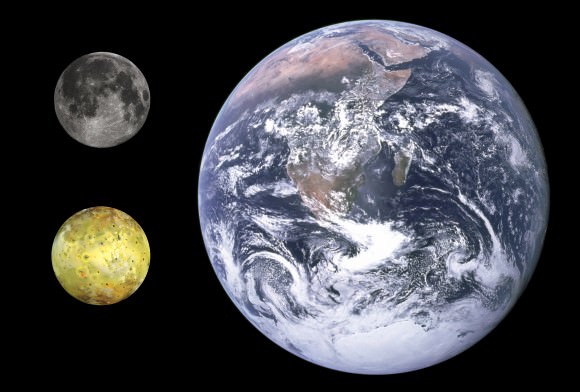
Io takes about 42.5 hours to complete one orbit around Jupiter and is in a 2:1 mean-motion orbital resonance with Europa and a 4:1 resonance with Ganymede. This means that it completes two orbits of Jupiter for every one orbit of Europa, and four orbits for every orbit Ganymede. This resonance helps maintain its orbital eccentricity (0.0041), which in turn provides the primary heating source for its geologic activity.
Io’s Composition and Surface Features:
With a mean density of 3.528 ± 0.006 g/cm3, Io has the highest density of any moon in the Solar System, and is significantly denser than the other Galilean Moons. Composed primarily of silicate rock and iron, it is closer in bulk composition to the terrestrial planets than to other satellites in the outer Solar System, which are mostly composed of a mix of water ice and silicates.
Models of Io’s interior indicate that it is differentiated between a silicate-rich crust and mantle and a core rich in iron or iron-sulfide. This core makes up 20% of the planet’s mass and has an estimated radius of 350 – 650 km (220–400 mi) – assuming it is composed almost entirely of iron. If, however, it consists of a mix of iron and sulfur, it likely has a radius of 550 – 900 km (340–560 mi). Due to the absence of a detectable magnetic field, this core is not in convection.
Similar models indicate that the mantle is composed of at east 75% magnesium-rich minerals and has a higher iron content (compared to silicon) than the Moon or Earth, but lower than Mars. The lithosphere of Io, composed of basalt and sulfur deposited by Io’s extensive volcanism, is estimated to be between 12 km and 40 km (7 mi – 25 mi) thick.
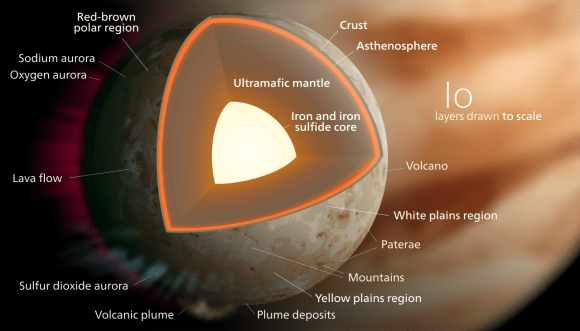
Based on magnetic measurements and heat-flow observations, a magma ocean is believed to exist some 50 km below the surface, which itself is about 50 km thick and makes up 10% of the mantle. It is estimated that the temperature in the magma ocean reaches 1473.15 K (1200 °C/2192 °F).
Unlike Earth and the Moon, Io’s main source of internal heat comes from tidal flexing, which is the result of Io’s orbital resonance with Europa and Ganymede. Such heating is dependent on Io’s distance from Jupiter, its orbital eccentricity, the composition of its interior, and its physical state.
The friction or tidal dissipation produced in Io’s interior due to this varying tidal pull creates significant tidal heating within Io’s interior, melting a significant amount of Io’s mantle and core. This heat is responsible for Io’s volcanic activity and its observed heat flow, and periodically causes lava to erupt up to 500 km (300 mi) into space (see below).
Surprisingly, the surface of Io is almost completely lacking in impact craters, and is instead covered in smooth plains dotted with tall mountains, pits of various shapes and sizes, and volcanic lava flows. It’s colorful appearance (a combination of orange, yellow, green, white/grey, etc.) is consistent with this, indicating that volcanic activity has both covered the surface in sulfuric and silicate compounds, and leads to surface renewal.
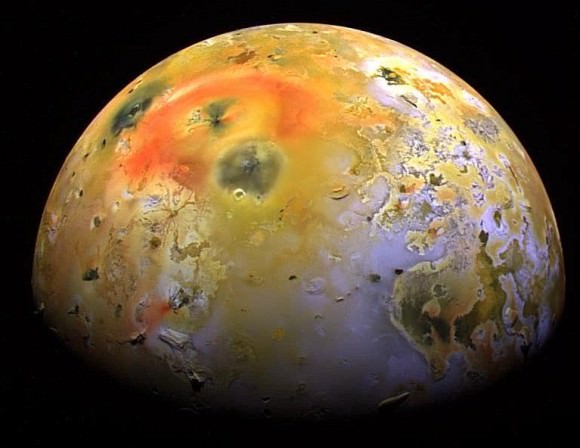
Sulfur dioxide frost is ever-present across the surface of Io, forming large regions covered in white or grey materials. Atomic sulfur is also seen in many places across Io, forming yellow to yellow-green regions. Sulfur deposited in the mid-latitude and polar regions is often radiation damaged, giving rise to Io’s red-brown polar regions.
Io contains little to no water, though small pockets of water ice or hydrated minerals have been tentatively identified, most notably on the northwest flank of the mountain Gish Bar Mons. In fact, Io has the least amount of water of any known body in the Solar System, which is likely due to Jupiter being hot enough early in the evolution of the Solar System to drive volatile materials like water off its surface.
Another prominent feature on Io are its mountains, which number between 100 and 150 and average 6 km (4 mi) in height, reaching a maximum of 17.5 ± 1.5 km (10.9 ± 0.9 mi) at South Boösaule Montes. Unlike mountains on Earth, Io’s mountains often appear as large, isolated structures with no apparent global tectonic patterns behind them.
Despite the presence of volcanism, nearly all of Io’s mountains are produced by tectonic activity and not volcanoes. Instead, most Ionian mountains form as the result of compressive stresses on the base of the lithosphere, which are the result of downward shifts from the continuous burial of volcanic materials.
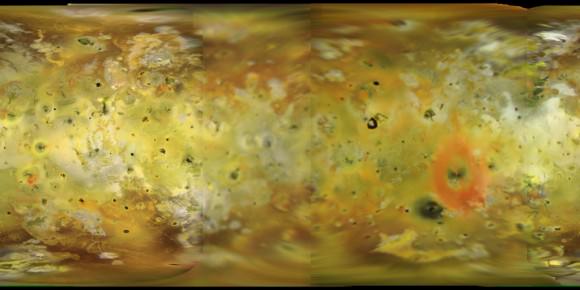
Mountains on Io also come in a variety of shapes, consisting of plateaus and tilted crustal blocks, with the small remainder being volcanic. Plateaus on Io resemble large, flat-topped mesas with rugged surfaces, whereas tilted crustal blocs appear with s shallow slope on one side (where it was previously flat terrain) and a sharp slope where sub-surface materials were pushed up by compressive stresses.
The few mountains that are linked to volcanism resemble small shield volcanoes, with steep slopes near a small, central caldera, and shallow slopes along their margins. These volcanic mountains are often smaller than the average mountain on Io, averaging only 1 to 2 km (0.6 to 1.2 mi) in height and 40 to 60 km (25 to 37 mi) in width.
Active Volcanoes:
The tidal heating produced by Io’s orbital eccentricity (which is due to its orbital resonance with Europa and Ganymede) has made it one of the most volcanically active worlds in the Solar System, with hundreds of volcanoes and extensive lava flows. This activity is not only responsible for sending lava jets up to 500 km (300 miles) into space, but has also had a profound effect on the surface geology and atmosphere of Io.
For instance, major eruptions can produce lava flows tens or even hundreds of kilometers long, composed mostly of basalt silicates, iron and magnesium-rich composites. At the same time, eruptions can send sulfur, sulfur dioxide gas and ash up to 200 km (120 miles) into space, depositing material for Io’s atmosphere, Jupiter’s magnetosphere, and leading to vast deposits of red, orange, green, black and white material on the surface.
The volcanic activity also leads to the many volcanic depressions that are seen across the surface, which generally have flat floors and steep walls. These features resemble terrestrial calderas, which occur on Earth when emptied lava chambers collapse, and are also seen on the Moon and Mars. However, on Io, these formations do not generally lie at the peak of a shield volcano, and are also generally larger – averaging 41 km (25 mi), with the largest (Loki Patera) measuring 202 km (126 km).
Atmosphere:
Io has an extremely tenuous atmosphere consisting of sulfur dioxide (SO²), with minor constituents such as sulfur monoxide (SO), sodium chloride (NaCl), sulfur monoxide (SO), and atomic sulfur (S) and oxygen (O). The maximum atmospheric pressure ranges from 3.3 x 10-5 to 3 x 10-4 pascals (0.3 to 3 nbar) but varies greatly in accordance with the time of day, latitude, volcanic activity and surface frost abundance. On the night side, the pressure dips to its lowest: 0.1 × 10-7 to 1 × 10-7 Pa (0.0001 to 0.001 nbar).
Io’s atmospheric temperature ranges based on altitude, with temperature on the surface and low altitudes averaging 110 K (-163.15 °C/-261.7 °F) with a minimum of 90 K (-183.15 °C/-297.7 °F)) and a maximum of 130 K (-143.15 °C/225.7 °F). At higher altitudes, where the thinner atmospheric density allows for heating by plasma, temperatures can reach as high as 1800 K (1526.85 °C/2780.3 °F).
Observations of Io’s atmosphere indicate that atmospheric densities are highest around volcanic vents, which confirms that active volcanism is what leads to the atmosphere’s replenishment. The most dramatic source of sulfur dioxide (SO²) are volcanic plumes, which pump 104 kg (11.023 tons) of sulfur dioxide per second into Io’s atmosphere on average, though most of this condenses back onto the surface.
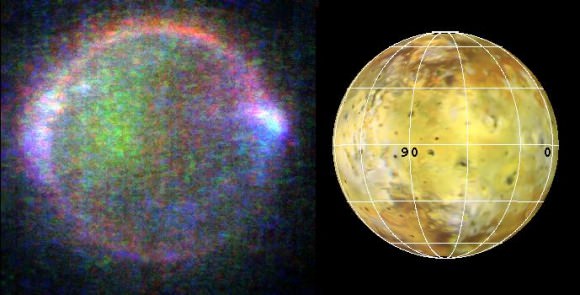
The other constituents of Io’s atmosphere – NaCl, SO, S, O – are derived from direct volcanic outgassing, the photodissociation of SO² (i.e chemical breakdown caused by interaction with solar radiation), or the sputtering of surface deposits by charged particles from Jupiter’s magnetosphere.
Much like Ganymede, Io experiences aurorae as a result of charged particles from Jupiter’s magnetosphere interacting with its atmosphere. In Io’s case, the aurorae are brightest near its equator. This is due to Io’s lack of an intrinsic magnetic field, which therefore causes electrons traveling from Jupiter to impact with its atmosphere directly.
Also, more electrons collide with Io’s atmosphere where the field lines are tangent to it (near the equator), which is also where the longest columns of atmospheric gas are located. Fainter aurora from oxygen atoms along the limb of Io and sodium atoms on Io’s night-side have also been observed.
Interaction with Jupiter’s Magnetosphere:
Io plays a significant role in shaping the Jovian magnetic field. When Jupiter sweeps up material from Io’s atmosphere – at a rate of 1 tonne (2000 pounds) a second – much of it goes into orbit around Jupiter, forming a neutral cloud of sulfur, oxygen, sodium, and potassium atoms.
These particles originate in Io’s upper atmosphere and are excited by collisions with ions in its plasma torus – a doughnut-shaped ring of ionized sulfur, oxygen, sodium, chlorine and electrons that surrounds the planet Jupiter. This torus is caused by neutral atoms in the “cloud” becoming ionized and carried along by the Jovian magnetosphere.
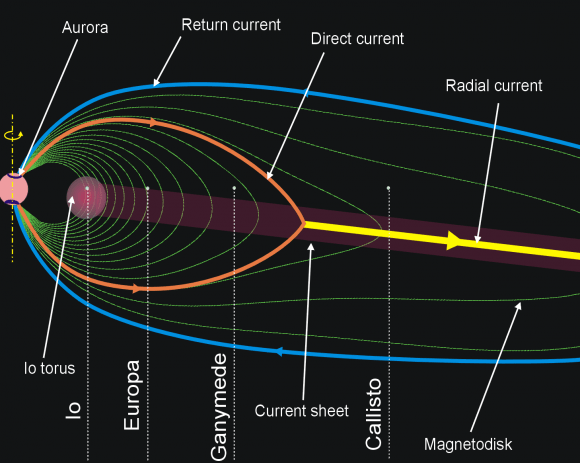
Jupiter’s magnetic field lines, which Io crosses, couple Io’s atmosphere and neutral cloud to Jupiter’s polar upper atmosphere by generating an electric current, known as the Io flux tube. This current produces an auroral glow in Jupiter’s polar regions (which is known as the Io footprint) and in Io’s atmosphere as well, particularly near the equator (see above).
The Jovian magnetic field lines that do get past Io’s ionosphere also induce an electric current, which is believed to be able to generate as much as 400,000 volts across itself, as well as an electric current of 3 million ampere.
The current also creates an induced magnetic field within Io’s interior, which is thought to be generated within a partially molten, silicate magma ocean 50 kilometers beneath itss surface. Similar induced fields have been discovered within the other Galilean moons; but in these cases, the fields are generated within the liquid, salt-water oceans that are believed to exist in their interiors.
Exploration of Io:
The first spacecraft to reach Io were the twin Pioneer 10 and 11 probes, which conducted flybys of the moon on December 3rd, 1973, and December 2nd, 1974, respectively. These missions provided valuable data which allowed for improved estimates of Io’s mass, its composition (silicate rock rather than water ice) and suggested that it had the highest density of the four Galilean satellites. The Pioneer crafts also revealed the presence of a thin atmosphere and intense radiation belts near its orbit.
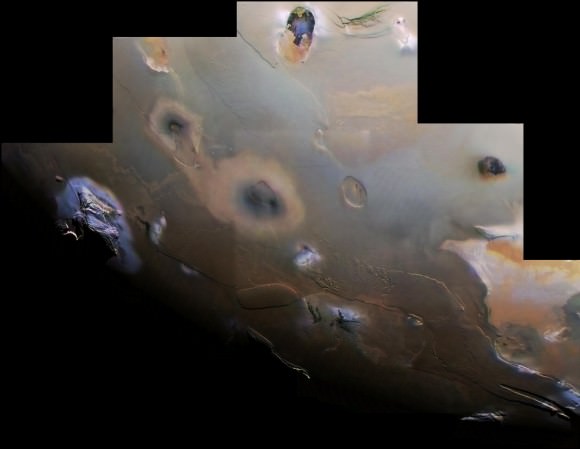
The twin probes Voyager 1 and Voyager 2 passed Io in 1979, and captured more detailed images of the the moon. These images were the first to reveal Io’s multi-colored landscape and many of its features. These included the lack of craters, its many pits, mountains, and features resembling lava flows. Further analysis of its images showed multiple plumes, indicating that Io was volcanically active.
Data from the Voyager missions also showed that the surface of Io is dominated by sulfur and sulfur dioxide frosts. These compounds also dominate its thin atmosphere and the torus of plasma centered on Io’s orbit. Comparisons with images taken by Voyager 2 also indicated changes in the surface between March and July, and that seven of the nine plumes noticed during Voyager 1‘s flyby were still active.
The following mission to Io was the Galileo spaceprobe, which arrived at Jupiter in 1995 and conducted a close flyby on December 7th. The encounter led to the discovery of its large iron core, similar to the other terrestrial planets of the Solar System. Galileo also observed the effects of a major eruption at Pillan Patera, confirmed the composition of volcanic eruptions, revealed large numbers of active volcanoes, and several surface changes that had taken place between the Voyager and Galileo missions (and even previous orbits).
The Galileo mission was twice extended – in 1997 and again in 2000 – during which time, the probe flew by Io a total of six times before 2002. Observations during these encounters revealed the geologic processes occurring at Io’s volcanoes and mountains, ruled out the presence of a magnetic field, and demonstrated the extent of volcanic activity.
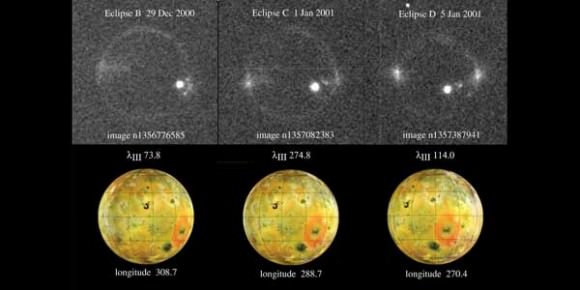
In December 2000, the Cassini spacecraft had a distant and brief encounter with the Jupiter system en route to Saturn, allowing for joint observations with Galileo. These observations revealed a new plume at Tvashtar Paterae and provided insights into Io’s aurorae.
The New Horizons spacecraft, while en route to Pluto and the Kuiper Belt, flew by Io on February 28th, 2007. During the encounter, numerous distant observations of Io were made, which included images of a large plume at Tvashtar, the first detailed observations of the largest class of Ionian volcanic plume, multiple new plumes, and images of a volcano near Girru Patera that was in the early stages of an eruption.
There are currently two missions planned for the Jupiter system, which included NASA’s Juno probe – which launched on August 5th, 2011. As part of its mission to study the origin and evolution of Jupiter, Juno could monitor Io’s volcanic activity using its near-infrared spectrometer (JIRAM).
The ESA’s planned Jupiter Icy Moon Explorer (JUICE) mission – which is scheduled for launch in 2022 – will not fly by Io, but it will use its instruments to monitor Io’s volcanic activity and measure its surface composition for two years before inserting into Ganymede’s orbit.
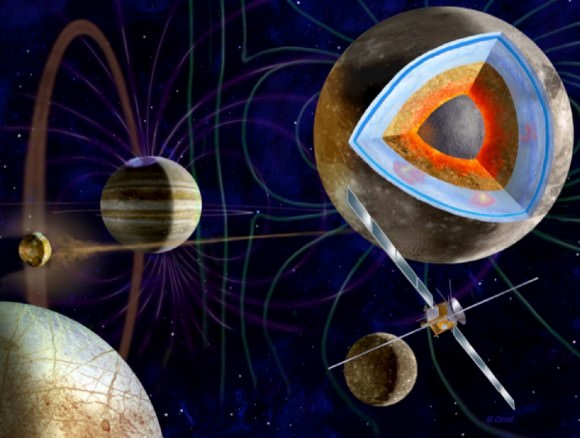
The Io Volcano Observer (IVO) was one of several proposals made as part of the NASA Discovery Program’s thirteenth mission. However, this mission was not selected as one of the five semi-finalists for consideration. Had it been chosen for Discovery Mission 13, it would have launched in 2021 and conducted multiple flybys of Io while in orbit around Jupiter, beginning in 2026.
Io is arguably one of the most fascinating and unique of all the known moons. In addition to being the fourth-largest moon in the Solar System, it is also the densest of all known satellites. It’s multi-colored surface is the most volcanically-active in the Solar System, but is also very cold and frosty. Higher into its thin atmosphere, conditions are extremely hot due to the presence of charged plasma, which also feeds Jupiter’s magnetosphere and generates an intense amount of electricity.
Without a doubt, future generations of explorers will be sending their probes there, attempting to unlock Io’s remaining mysteries, and maybe even looking for ways to tap it’s induced magnetic field. However, with its regular eruptions, intense radiation, and hostile surface, it is a veritable certainty that no human beings will ever set foot there.
We have many interesting articles of Io, Jupiter, and the Galilean Moons here at Universe Today. Her is one about its many active volcanoes, how they are “in the wrong place“, the first-ever geologic map, and its atmosphere.
For more information, check out NASA’s Solar System Exploration and Views of the Solar System.

